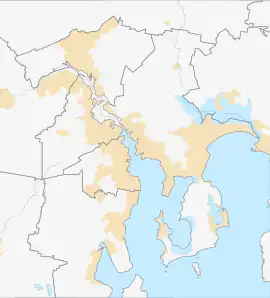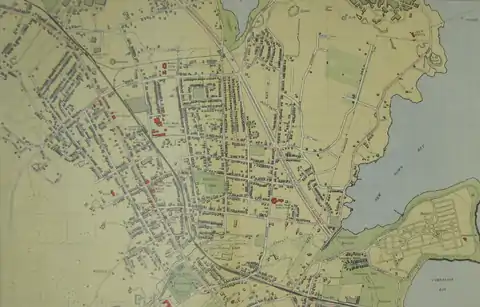Moonah, Tasmania
Moonah is a residential locality in the local government area (LGA) of Glenorchy in the Hobart LGA region of Tasmania. The locality is about 3 kilometres (1.9 mi) south-east of the town of Glenorchy. The 2016 census recorded a population of 5421 for the state suburb of Moonah.[1] It is a suburb in the city of Hobart, located approximately 5 km north of the central business district of Hobart, and lying directly north of the inner city suburb New Town.
| Moonah Hobart, Tasmania | |||||||||||||||
|---|---|---|---|---|---|---|---|---|---|---|---|---|---|---|---|
 Moonah, looking roughly north-east out towards the Derwent River | |||||||||||||||
 Moonah | |||||||||||||||
| Coordinates | 42°50′35″S 147°18′7″E | ||||||||||||||
| Population | 5,421 (2016 census)[1] | ||||||||||||||
| Postcode(s) | 7009 | ||||||||||||||
| Location | 3 km (2 mi) SE of Glenorchy | ||||||||||||||
| LGA(s) | City of Glenorchy | ||||||||||||||
| Region | Hobart | ||||||||||||||
| State electorate(s) | Clark | ||||||||||||||
| Federal division(s) | Clark | ||||||||||||||
| |||||||||||||||
History
Moonah was gazetted as a locality in 1961. The name has been in use since 1895. It is believed to be an Aboriginal word for "gum tree".[2]

Originally land given free to settlers along the banks of the New Town Rivulet, this area eventually became known as the suburbs of New Town and Moonah.
Geography
New Town Rivulet forms most of the southern boundary.[3]
Road infrastructure
National Route 1 (Brooker Highway) passes along the eastern boundary, from where several roads provide access to the locality.[2][4]
Today
The key transport axis of the suburb is Main Road, which runs between Derwent Park to the north and New Town to the south. Metro Tasmania routes run along this corridor – formerly a tram route[5] – with several stops in Moonah.[6]
The Moonah shopping district is located largely between Florence Street and Amy Street, and includes a range of retail shops, restaurants and cafes, offices, banks, service stations, a newsagent, an auction house and a post office.
Large areas of the suburb are residential. Industrial zones are found along Charles St, Sunderland St and Gormanston Rd. Moonah is home to a major office of the state water company TasWater.
Glenorchy City Council's Moonah Arts Centre opened in 2015 and hosts exhibitions, events and classes.[7]
Smelter contamination
The Risdon Zinc Works (trading as Nyrstar Hobart) at nearby Lutana, which has been in operation since 1917, continues to produce heavy metal contaminants affecting the air, land and estuary waters surrounding Greater Hobart.[8]
Drawing from data complied in the National Pollutant Inventory, a report by the Australian Conservation Foundation placed Hobart at number 6 of Australia's most polluted cities in 2018. The data identified medium levels of air pollution in postcodes 7009 (Moonah, Lutana, Derwent Park, West Moonah) and 7010 (Glenorchy, Rosetta, Montrose, Goodwood, Dowsing Point) with average air contaminate readings of 40% NOx (nitric oxide (NO) and nitrogen dioxide (NO
2)), and sulfur dioxide (SO2) contributing 57% of airborne emissions.[9][10]
The Tasmanian Planning Scheme does not require the Glenorchy City Council to notify prospective buyers about potential land contamination within the City of Glenorchy.[11]
References
- "2016 Census Quick Stats Moonah (Tas.)". quickstats.censusdata.abs.gov.au. Australian Bureau of Statistics. 23 October 2017. Retrieved 2 April 2021.
- "Placenames Tasmania – Moonah". Placenames Tasmania. Select "Search", enter "144D", click "Search", select row, map is displayed, click "Details". Retrieved 2 April 2021.
- Google (2 April 2021). "Moonah, Tasmania" (Map). Google Maps. Google. Retrieved 2 April 2021.
- "Tasmanian Road Route Codes" (PDF). Department of Primary Industries, Parks, Water & Environment. May 2017. Archived from the original (PDF) on 1 August 2017. Retrieved 2 April 2021.
- "Moonah". Our Tasmania. Retrieved 29 May 2020.
- "Hobart North Network" (PDF). Metro Tas. Retrieved 13 July 2020.
- "About MAC". Moonah Arts Centre. Retrieved 13 July 2020.
- Obendorf, David (29 May 2006). "From the archives: the State of the Derwent". Tasmanian Times. Retrieved 22 May 2023.
- "The Dirty Truth: Australia's Most Polluted Postcodes" (PDF). Australian Conservation Foundation. 1 November 2018. Retrieved 22 May 2023.
- Hermant, Norman; Clark, Emily (16 November 2018). "Australia's pollution mapped by postcode reveals nation's 'dirty truth'". Australian Broadcasting Corporation. Retrieved 22 May 2023.
- "NOTIFICATION TO PURCHASERS: CONTAMINATED LAND IN LUTANA" (PDF). Glenorchy City Council. 28 March 2022. Retrieved 22 May 2023.
